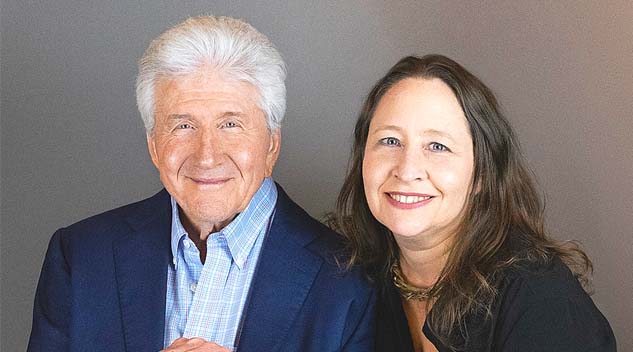#Ron #Gard #Christie #Gard #Antiques #Arts #Weekly
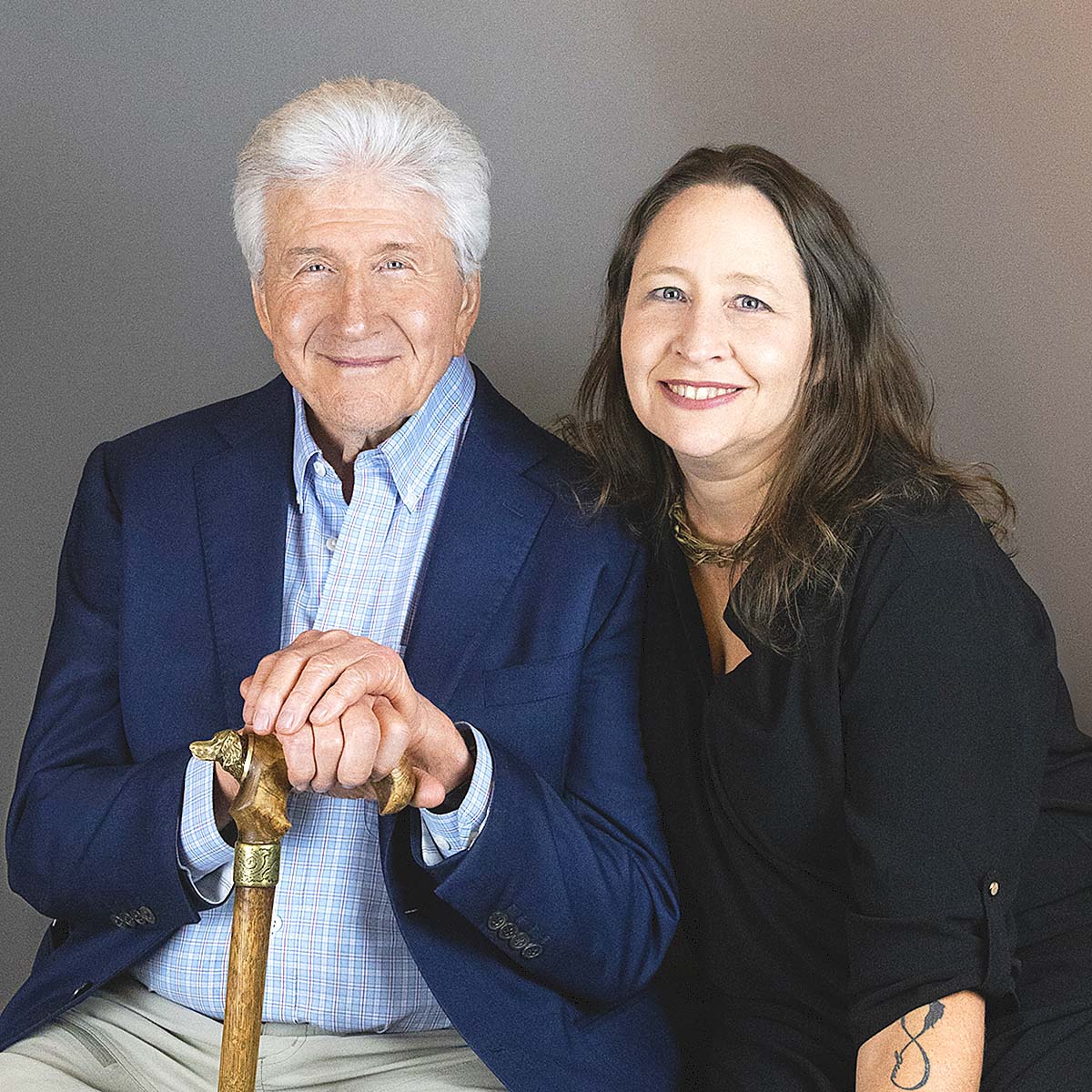
Co-authors Ron Gard and Christie Gard.
Antiques and The Arts Weekly caught up with Ron Gard to learn about his collection of dog collars and other “dogiana” and discussed his latest book, Whose Dog are You? Gard is a lover of antique decoys, American folk art, natural history and all things related to dogs. He has served on multiple museum boards and is also a conservationist. His daughter and co-author, Christie Gard, works with the collection and historical archives at Dallas’s Longhorn Ballroom and has a background in photography and exhibit design from working with museums and nonprofits.
What first inspired you to put this book together?
RG: I’m a member of the Dallas Antiques and Fine Arts Society. I’d done some presentations on antique duck decoys for them and the Dallas Glass Club and they asked me to do one on dog collars after some of them visited my house and saw my collection. My friend and photographer Jeff Moore was in town, and I asked him to take pictures of the collars, which I used in the presentations I gave to both organizations. After the meeting, some ladies from the Dallas Glass Club suggested I do a book because they had never heard of antique collars, and that’s how it got started. We used Jeff Moore’s photography and then as Christie got more into the research, we ended up adding a lot more to the book, like her idea of having the dogs model the collars.
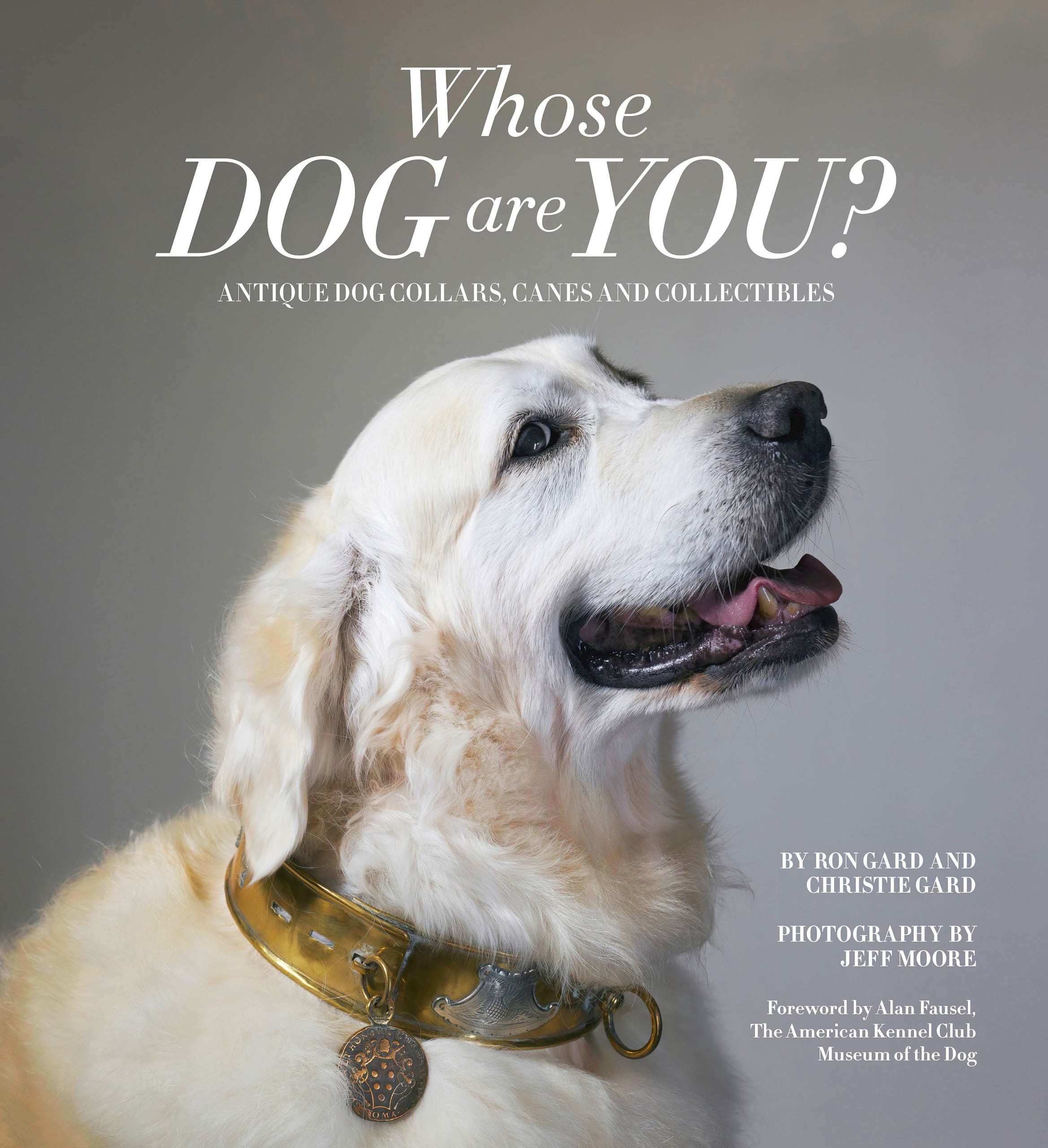
How did you become a collector of dog collars and dog-related items?
RG: The first things that I ever collected I did so because I love dogs. When I was around 4 or 5 years old, I cut dog pictures out of magazines and put them in a box — that was my first collection. Then, on our family farm, I would find Native American artifacts and pottery, deserted bird nests, animal skulls and rocks and minerals. There was a 100-year-old house on the farm that I would put all this stuff in like it was my own little natural history museum.
I had never even thought about antique dog collars, or even knew there was such a thing, until my wife Jane and I were at the German Hunting and Fishing Museum in Munich. In a display case, there was a beautiful old antique brass and leather dog collar, and I immediately decided that I wanted to find some more.
Ten or 15 years went by and I hadn’t seen another antique dog collar. Then one day I was at an antique show at Dallas Fair Park, and Betty Bell, a friend and antique dealer, had four of them in a case. I was immediately interested. She explained that these were part of a collection she had purchased from an Ohio estate. I told her to show me the rest and I ended up buying all of them. That started my collection.
Can you tell me about one of the most unique or special collars in your collection?
RG: My most unique collar is the Mickey Mallory collar. It has pretty turquoise stones on it and has a nice inscription thanking Mallory for his fine and faithful service to the American Red Cross. When we started working on the book and Christie was doing the research, she found that Mickey Mallory was an Irish terrier who used to walk around the Atlantic City Boardwalk in the 1910s and 1920s with a bucket around his neck collecting money for the Red Cross. So that is not only one of the most beautiful collars I have but to know the actual dog that wore it and that he had all that good publicity makes it extra special to us. He was famous, actually. Christie found several articles they’d written about him and a photograph. He even got arrested once for soliciting without a license or something like that. That’s my favorite one.
Another favorite is a beautiful sterling silver collar that I bought from a London auction at 4 in the morning. It is engraved “Miss R Jenkins, Charlton Hill, 1691.”
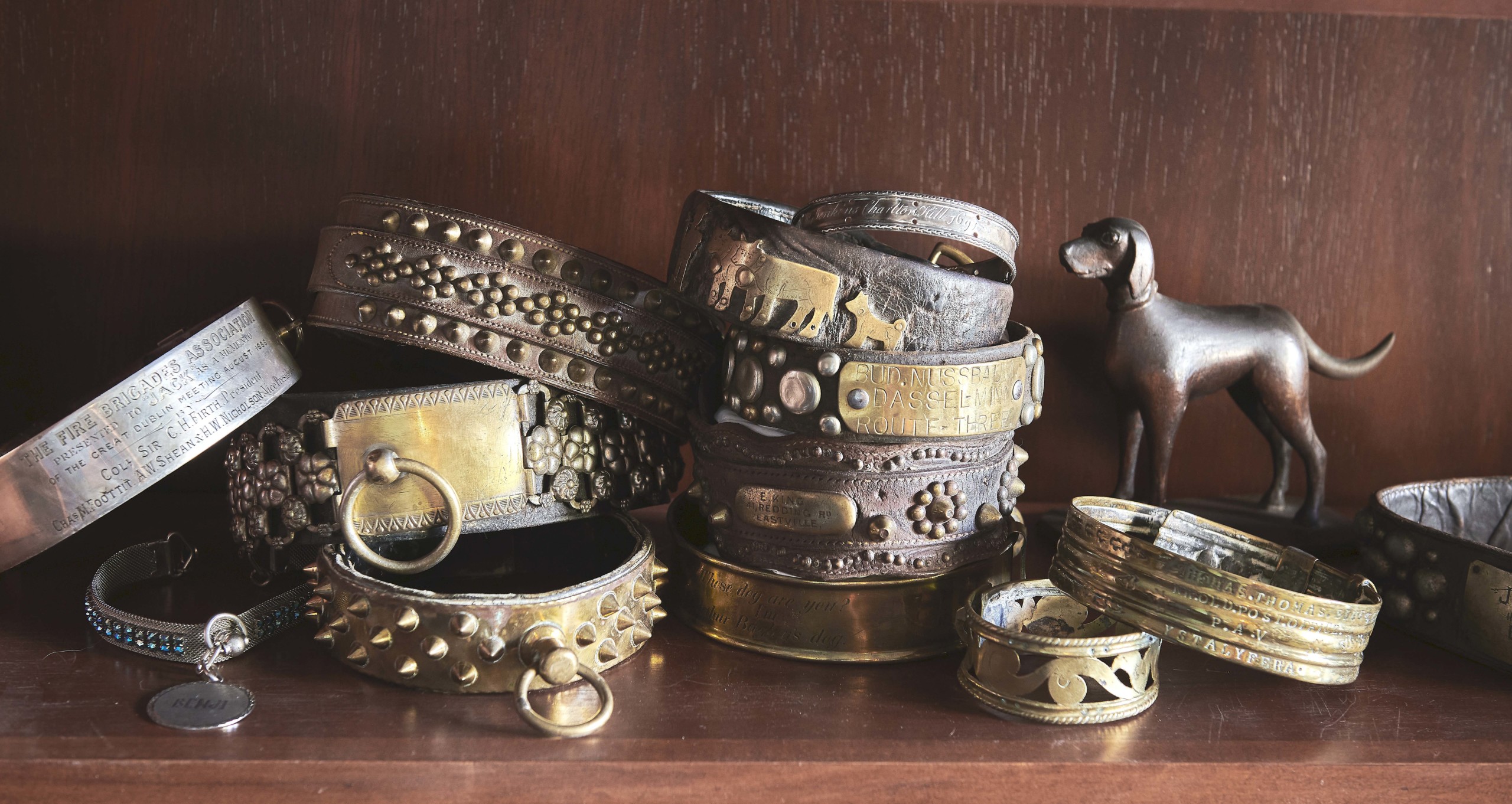
Some of the dog collars in Ron’s collection. Photo: Elizabeth Lavin for D Magazine.
What is your most recently acquired collar?
RG: My newest collar, which has a tag that says “To Benji, from Lassie,” came from a TV memorabilia auction that Christie went to with her boyfriend. It is really pretty with little jewels and delicate silver. Christie’s boyfriend bought it, and I bought it from him after the sale. Christie contacted the collector, James Comisar, who consigned the auction and he explained that he had purchased animal trainer Frank Inn’s career memorabilia from his daughter, which included the collar and a number of other Lassie memorabilia that Inn received from the original Lassie trainer, Rudd Weatherwax, a close friend and colleague. Christie then researched further and discovered that Frank Inn was the original owner and trainer of Benji, and he studied under Rudd Weatherwax at the beginning of his career. This collar was a gift between the two talented trainers of two famous TV and movie dogs. I purchased it after we completed this book, but we’d love to include it if we do a second edition.
How did you conduct the research for this project? I’m sure it couldn’t have been easy to source the details of some of the Sixteenth or early Seventeenth Century collars.
CG: The first step was cataloging all the collars, with their inscriptions and specs. Then I suppose the research began with studying the collar itself and running searches on all names, places and markings, often multiple times. Sometimes we had information from auction houses that directed the search. However, there was at least one instance where my research proved the auction house’s assumption to be incorrect. It is amazing how a slight change to search keywords can yield different results. Very old newspaper articles were very helpful, and I am so grateful to the people who work tirelessly to digitize historical documents.
I was often able to find some information about the owners, but little about the dogs themselves. Still, imagining the owner in the time period and place can give you context to imagine that dog’s life as well. And with the collars that had very generic information, like a single name, well those had to speak for themselves. But I think even the size and type of collar can spark imagination about what that dog may have looked like and the type of life they lived.
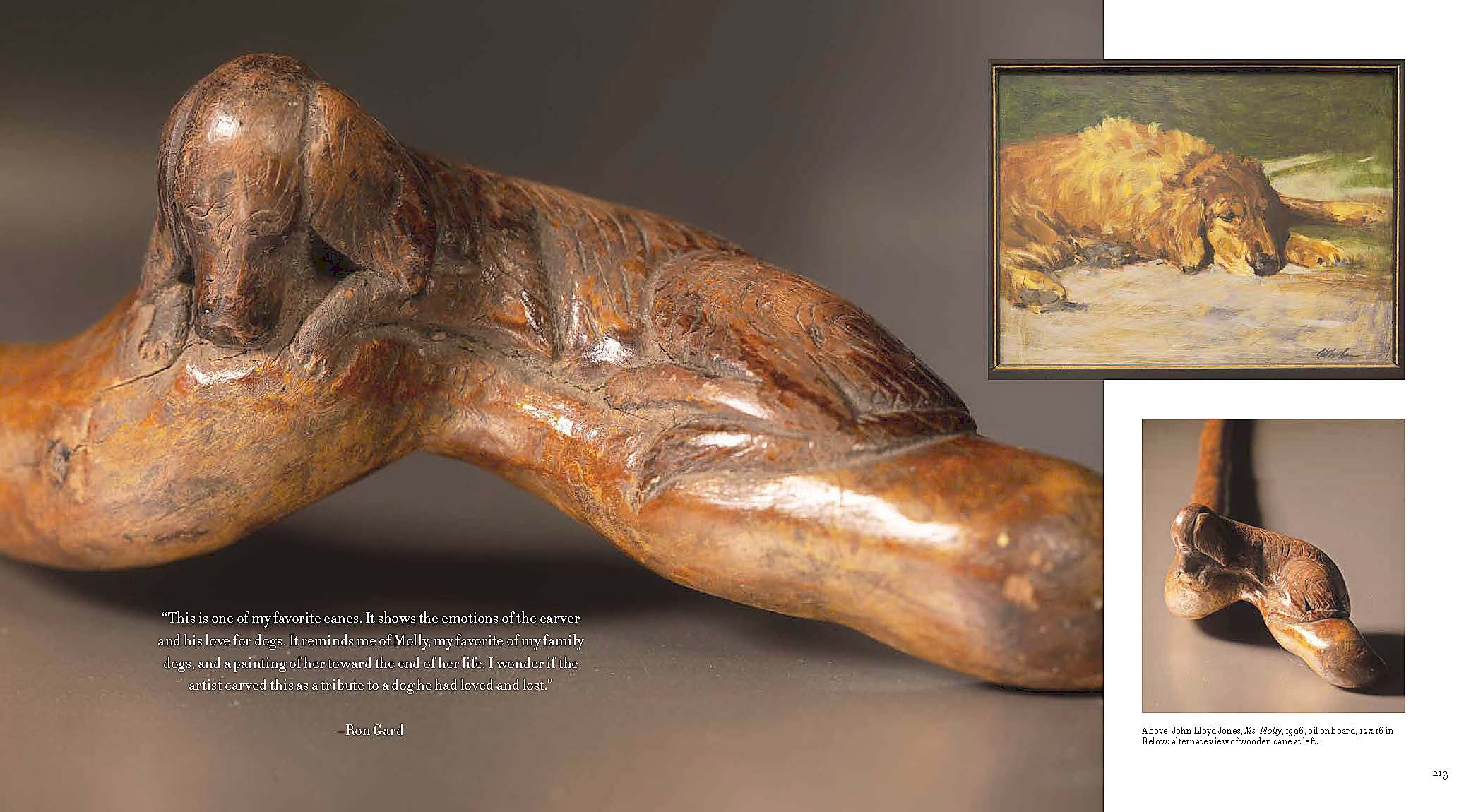
Featuring the carved handle of a cane and the 1996 portrait of “Ms Molly” by John Lloyd Jones, this page is one of Ron’s favorites in the whole book. Molly was Ron’s beloved golden retriever and he thinks the cane resembles her, adding extra sentimental value.
The book primarily focuses on collars but also includes other dog collectibles, or “dogiana,” such as canes, bookends, pens and knives. Is there one item that is especially sentimental or noteworthy to you?
RG: I’ve been collecting canes for most of my life, I think mainly because where I grew up in East Texas there were a lot of old-timer carvers that made their own canes. Since I collected folk art, I started collecting these carved canes and later turned to collecting only dog handle canes.
One of my favorite pictures in the book is of a folk-art cane that resembles my golden retriever, Molly — one of my favorite dogs of all time. Shortly before she died, I had my friend, John Lloyd Jones paint a portrait of her laying down. A few years later I found this cane and thought it looked just like Molly looks in her portrait. We put them in the book together so you can see the resemblance.
Do you have any stories behind the models in your book?
RG: We already had most of the dogs we needed but we couldn’t find a mastiff, and a lot of these collars are really big and had belonged to mastiffs and saint bernards. I called the vets, I called breeders, but no one knew of anyone that had a mastiff. Then, the day before the photographer was coming back for the second shoot, I was in the car with my son, David, and saw this lady walking down the street with a gigantic dog. I asked David to pull over so I could talk to the lady. As I got out of the car and walked towards her, the giant dog was staring at me and the lady was probably a bit suspicious of me, too. But I asked her about the dog and told her about the book and the photo shoot. She agreed to participate and brought the dog to the house the next morning when the photographer was there. We had our mastiff model. Her name is Jude.
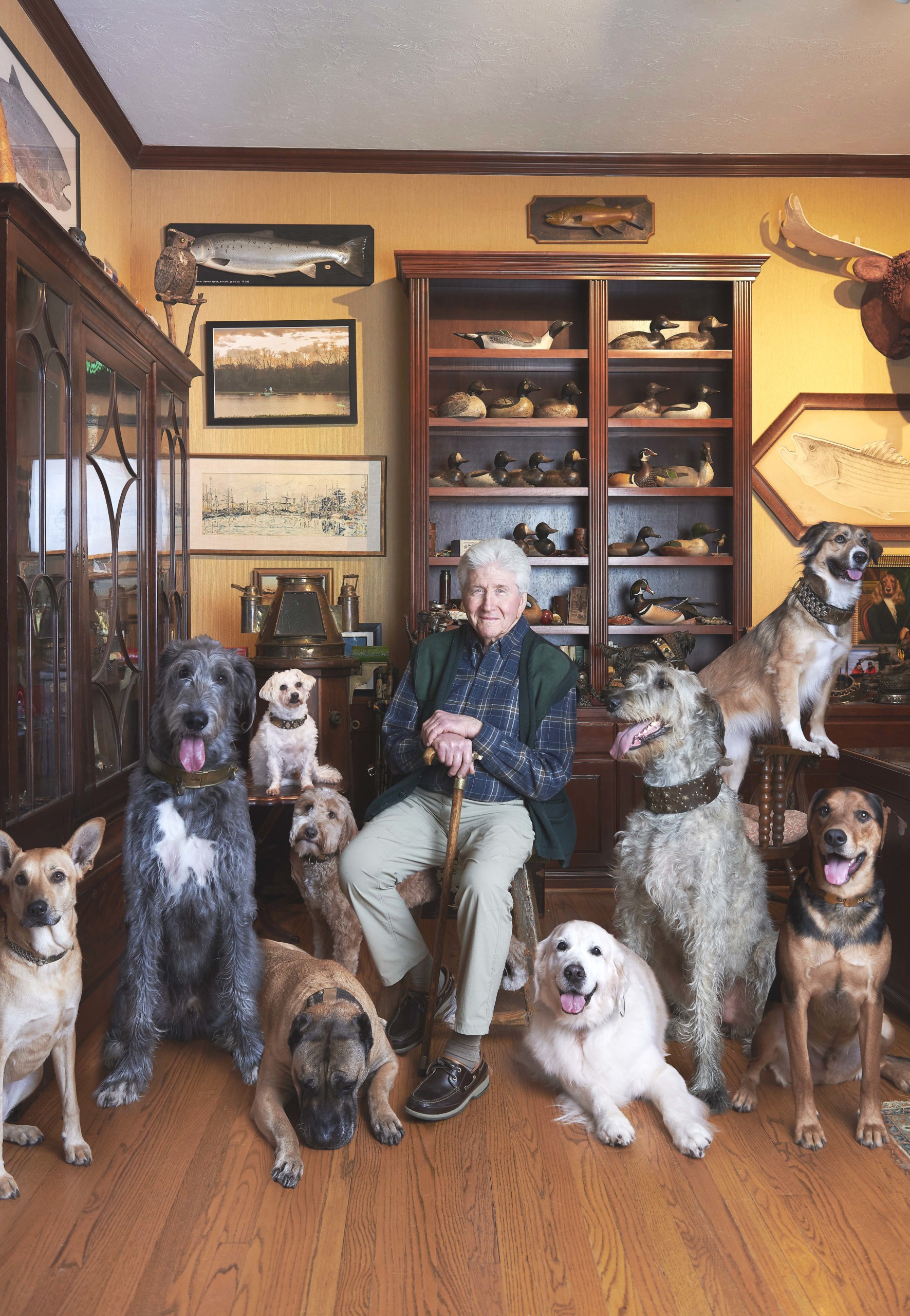
Ron Gard, photographed in his home with his decoy collection and some of the dogs that were featured in his book. Photo: Elizabeth Lavin for D Magazine.
This is the first time you’ve collaborated with your daughter, Christie. How did she come to be a part of the project?
RG: Christie was helping and was so important to design and research and she named the book. I asked her to be the co-author. It was her idea to use dogs as models.
CG: I had been helping my dad with his collections and presentations when he mentioned that someone suggested he write a book on his collar collection. As a huge dog-lover myself as well as a fan of dog photography, I immediately imagined portraits of modern dogs wearing old collars. Aesthetically I loved the idea, but I also thought it would be a good way to draw interest from people who love dogs but had never thought about antique collars, much less collecting them.
As we began organizing the book in earnest and my role grew to cataloging and conducting the research, Dad asked if I would be a co-author. Of course, I said yes. But I doubt he realized that naming me co-author would lead to me being quite so dedicated and passionate about editing and design decisions!
Your book is a fascinating bridge between collecting antiques and loving dogs. I think it is in a unique position to inspire others to begin collecting. Is this something you considered, or perhaps even hoped for, when starting the project?
RG: Yes, we collectors like to share our collections with other collectors as well as non-collectors who enjoy learning about them. It’s especially joyful when it inspires someone to begin a collection of their own.
—Carly Timpson
[Editor’s note: Whose Dog are You? by Ron Gard & Christie Gard with photography by Jeff Moore, Lake Emma Press, Dallas, 2023, 259 pages, $85, hardcover, is available to purchase at www.whosedogareyou.com.]

